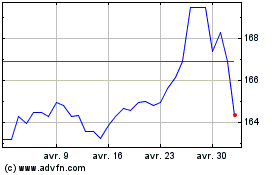Euro Climbs After ECB Weidmann's Remarks
26 Mars 2018 - 10:20AM
RTTF2
The euro strengthened against its most major counterparts in the
European session on Monday, following comments from the European
Central Bank Governing Council Member Jens Weidmann that market
expectations for a rate increase by the ECB around the middle of
next year were "not completely unrealistic".
The ECB should begin policy normalization without any delay,
Weidmann, who also heads Bundesbank, said in Vienna.
Hopes for a rate hike around mid-2019 are "not completely
unrealistic," he added.
The "diversity of views" on the Governing Council is an
advantage, he said. "So long as we agree on the goal, it surely
can't be a bad thing to discuss the right way to get there."
Sentiment improved as concerns eased over the U.S. action of
selective imposition of import tariffs.
U.S. Treasury Secretary offered an olive branch to China over
possible sanctions, helping raise expectations that the U.S. trade
policy will be more selective and tactical than first feared to
give Washington leverage in pushing for big change.
The euro area is set to continue expanding buoyed by global
economic activity growth and export demand, according to Eurozone
Economic Outlook jointly published by Ifo Institute, Italy's
statistical office Istat and the KOF Swiss Economic Institute.
Gross domestic product is forecast to grow 0.6 percent each in
the first and second quarters of 2018. But it is expected to slow
slightly to 0.5 percent in the third quarter.
The currency traded mixed against its major opponents in the
Asian session. While it held steady against the pound and the
greenback, it rose against the yen and the franc.
The single currency climbed to a 6-day high of 1.1745 against
the franc, near 3-week high of 1.2417 against the greenback and a
4-day high of 130.53 against the yen, off its early lows of 1.1690,
1.2350 and 129.28, respectively. The euro is poised to test
resistance around 1.20 against the franc, 1.26 against the
greenback and 132.5 against the yen.
The single currency recovered to 1.6054 against the aussie, from
an early low of 1.5976. The next possible upside target for the
euro is seen around the 1.62 level.
The euro reversed from an early low of 1.5888 against the
loonie, rising to a 5-day high of 1.6004. On the upside, 1.61 is
seen as the next resistance level for the euro.
The 19-nation currency bounced off to 1.7043 against the kiwi,
from a 10-day low of 1.6969 hit at 2:15 am ET. The next likely
resistance for the euro is seen around the 1.72 level.
Data from Statistics New Zealand showed that New Zealand
recorded a merchandise trade surplus of NZ$217 million in
February.
That exceeded expectations for a deficit of NZ$100 million
following the downwardly revised NZ$655 million deficit in
January.
On the flip side, the euro was defensive against the pound with
the pair trading at 0.8725. Next key support for the euro is seen
around the 0.86 level.
Figures from UK Finance showed that UK mortgage approvals
declined in February.
The number of loans approved for house purchases fell
more-than-expected to 38,120 from 40,031 in January. The expected
level was 39,000.
Euro vs Yen (FX:EURJPY)
Graphique Historique de la Devise
De Mar 2024 à Avr 2024

Euro vs Yen (FX:EURJPY)
Graphique Historique de la Devise
De Avr 2023 à Avr 2024
